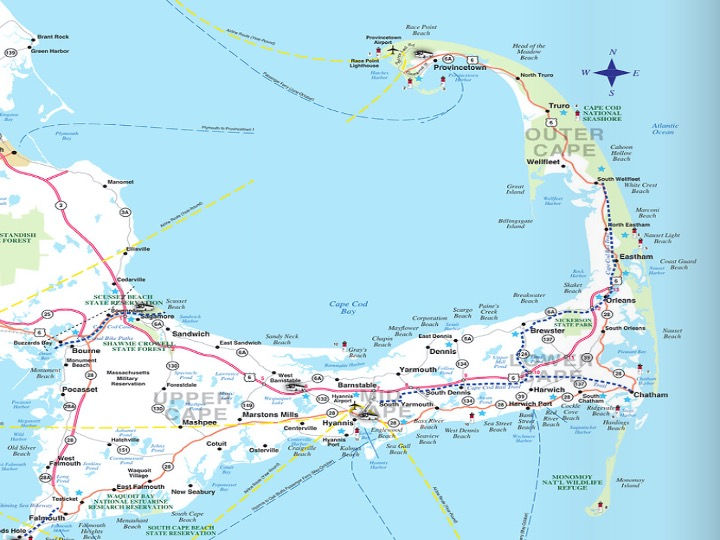

Savvy Sightseer - tips and insights for seasoned travelers!


The Lead Horse is shinier and more elaborate than the others.

Replica of the original Pilgrim ship.

Bob Gasoi Memorial Art Alley
Cape Cod, MA: Coastal Charmer
English seafarer Bartholomew Gosnold explored and mapped the Cape in 1602, and was the first to name it for the abundance of cod fish he found there. Subsequent explorers also mapped the region, including French voyager Samuel de Champlain in 1605. Some played with renaming it, like Capt. John Smith who charted the New England coastline in 1614 after setting up Jamestown, VA. He christened the landmass Cape James in honor of King James I, but it was Gosnold’s naming that stuck, and it was Cape Cod Bay that a boatload of Pilgrims sailed into and decided to weigh the Mayflower’s anchor in 1620. They only lasted a few weeks finding the land too sandy for farming and the local natives not too friendly, so they headed across the bay to their more famous landing spot at Plymouth.
The Cape has retained its quintessential New England look and offers great views of Colonial-era architecture, seascapes and memorials. A real treat is to visit the Heritage Museum and Gardens in Sandwich, the oldest town on the Cape. Pharmaceutical giant JK Lilly III bought a 100-acre estate in 1967 with the goal of creating a museum to showcase his obsession with vintage cars. The center has morphed into a non-profit, multi-faceted establishment: part garden, part automobile gallery, part art museum. Thrown into that mix are also a classic wood-carved carousel, as well as historic and military exhibits – in all, an offering of over 18,000 elements. There’s even a STEM-based school for pre-K and first grade students. Throughout the sprawling acreage are all kinds of foliage. Building on a former owner’s horticultural passions – he had cultivated up to 200,000 rhododendron hybrids – the Heritage Gardens now feature various types of species so something is in bloom every time of the year.










Click above grid for slideshow.
Provincetown
Provincetown – the Pilgrims’ original landing place in MA. Also referred to as P-town or “Land’s End,” it has been a destination of choice for artists, bohemians and writers for decades. There is nothing subtle or subdued about the town; rather the opposite – daring, colorful, flamboyant are better adjectives. It is home to the oldest continuous art colony in the country, a cultural phenomena that started when Charles W. Hawthorne opened the Cape Cod School of Painting in 1899. Less than two decades later, the Boston Globe headlined with “Biggest Art Colony in the World in Provincetown.” Commercial Street is a study in contrasts - there are remnants of a dignified era amid some more outrageous facades and artwork.
Click above video to watch Tripod the Whale take a dip.
Architecture includes impressive old churches and lavish homes of former captains and wealthy merchants, varying in style from Greek Revival to Victorian architecture. And then there's the Bob Gasoi Memorial Art Alley. This particular collection started when Gasoi, a local artist, started transforming the ugly winter look of boarded up windows on a seasonal shop back in the late 1980s. The project has since become a movement and the result is an eclectic collection of vibrant art by various artists, described by one writer as, “overwhelmingly beautiful, loud, and at times, hilarious.” Reports are that initially the images were considered quite controversial and not exactly welcomed among locals, however, the town has since come to embrace the alley as a landmark draw for tourists. Not to forget the maritime legacy of the Cape - there's the Memorial to the Pilgrims, marking their first landing in the New World, a schooner taking up the second floor of the local library, and of course Whale Watching cruises!










Click above grid for slideshow.
Plymouth
After the Pilgrims looted a buried Indian corn stash, and clashed with the local tribe, they decided the lower Cape was not a hospitable place for them. Although they gave up on their original landing place, they still wanted to stay in the region and thought their luck might be better across the Bay. Scouting parties discovered remnants there of a large Native America settlement that had suffered complete annihilation from European-brought diseases and plagues. While the Wampanoag residents were gone, the clearing remained, saving Pilgrims the need to fell trees. Unlike the sandy land of Provincetown, the land in what became known as Plimouth was much better for farming. Despite losing more than half their original contingent over their first harsh year there, the town was destined to became the oldest municipality in New England, and one of the oldest in the US, recognized as the first permanent colony of MA. In the harbor today, a full-scale replica of the 106 ½’ long Mayflower gives modern visitors a taste of the cramped conditions the determined emigrees – 102 passengers along with up to 30 crew – endured during the 66 days crossing the turbulent and treacherous Atlantic Ocean




Click on the pictures above for a closer look at Plymouth.


